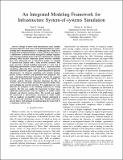| dc.contributor.author | de Weck, Olivier L. | |
| dc.contributor.author | Grogan, Paul Thomas | |
| dc.date.accessioned | 2014-01-17T14:36:10Z | |
| dc.date.available | 2014-01-17T14:36:10Z | |
| dc.date.issued | 2013-04 | |
| dc.identifier.isbn | 978-1-4673-3108-1 | |
| dc.identifier.isbn | 978-1-4673-3107-4 | |
| dc.identifier.isbn | 978-1-4673-3106-7 | |
| dc.identifier.uri | http://hdl.handle.net/1721.1/84056 | |
| dc.description.abstract | Design of future hard infrastructure must consider emergent behaviors from cross-system interdependencies. Understanding these interdependencies is challenging due to high levels of integration in high-performance systems and their operation as a collaborative system-of-systems managed by multiple organizations. Existing modeling frameworks have limitations for strategic planning either because important spatial structure attributes have been abstracted out or behavioral models are oriented to shorter-term analysis with a static network structure. This paper presents a formal modeling framework as a first step to integrating infrastructure system models in a system-of-systems simulation addressing these concerns. First, a graph-theoretic structural framework captures the spatial dimension of physical infrastructure. An element's simulation state includes location, parent, resource contents, and operational state properties. Second, a functional behavioral framework captures the temporal dimension of infrastructure operations at a level suitable for strategic analysis. Resource behaviors determine the flow of resources into or out of nodes and element behaviors modify other state including the network structure. Two application use cases illustrate the usefulness of the modeling framework in varying contexts. The first case applies the framework to future space exploration infrastructure with an emphasis on mobile system elements and discrete resource flows. The second case applies the framework to infrastructure investment in Saudi Arabia with an emphasis on immobile system elements aggregated at the city level and continuous resource flows. Finally, conclusions present future work planned for implementing the framework in a simulation software tool. | en_US |
| dc.description.sponsorship | American Society for Engineering Education. National Defense Science and Engineering Graduate Fellowship | en_US |
| dc.language.iso | en_US | |
| dc.publisher | Institute of Electrical and Electronics Engineers (IEEE) | en_US |
| dc.relation.isversionof | http://dx.doi.org/10.1109/SysCon.2013.6549926 | en_US |
| dc.rights | Creative Commons Attribution-Noncommercial-Share Alike 3.0 | en_US |
| dc.rights.uri | http://creativecommons.org/licenses/by-nc-sa/3.0/ | en_US |
| dc.source | Prof. de Weck via Angie Locknar | en_US |
| dc.title | An integrated modeling framework for infrastructure system-of-systems simulation | en_US |
| dc.type | Article | en_US |
| dc.identifier.citation | Grogan, Paul T., and Olivier L. de Weck. “An integrated modeling framework for infrastructure system-of-systems simulation.” In 2013 IEEE International Systems Conference (SysCon), 483-490. Institute of Electrical and Electronics Engineers, 2013. | en_US |
| dc.contributor.department | Massachusetts Institute of Technology. Department of Aeronautics and Astronautics | en_US |
| dc.contributor.department | Massachusetts Institute of Technology. Engineering Systems Division | en_US |
| dc.contributor.approver | de Weck, Olivier | en_US |
| dc.contributor.mitauthor | Grogan, Paul Thomas | en_US |
| dc.contributor.mitauthor | de Weck, Olivier L. | en_US |
| dc.relation.journal | Proceedings of the 2013 IEEE International Systems Conference (SysCon) | en_US |
| dc.eprint.version | Author's final manuscript | en_US |
| dc.type.uri | http://purl.org/eprint/type/ConferencePaper | en_US |
| eprint.status | http://purl.org/eprint/status/NonPeerReviewed | en_US |
| dspace.orderedauthors | Grogan, Paul T.; de Weck, Olivier L. | en_US |
| dc.identifier.orcid | https://orcid.org/0000-0001-6677-383X | |
| dc.identifier.orcid | https://orcid.org/0000-0001-8986-4806 | |
| mit.license | OPEN_ACCESS_POLICY | en_US |
| mit.metadata.status | Complete | |
